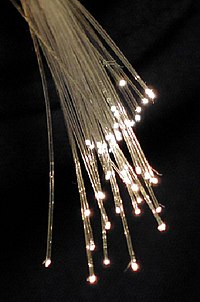
Photo from wikipedia
Adhesives that enable bonding and especially debonding on demand (DoD) have attracted rapidly growing interest in the last decade, as these capabilities greatly improve the functionality of adhesives, particularly in… Click to show full abstract
Adhesives that enable bonding and especially debonding on demand (DoD) have attracted rapidly growing interest in the last decade, as these capabilities greatly improve the functionality of adhesives, particularly in connection with temporal fixation, repair, and recycling. Indeed, DoD techniques have already entered commercial exploitation in applications such as easily removable wound dressings, temporal fixation in semiconductor manufacturing, and the repair, replacement, or recycling of components. While most approaches to debonding rely on heat to reduce the adhesive strength via physical property changes of the adhesive, optically switchable adhesives have been much less explored. However, light is an attractive stimulus, as it allows an efficient, contactless, remote stimulation that can be temporally and spatially controlled. In this Progress Report, recent developments in the domain of photoswitchable adhesive materials are highlighted. After a discussion of main strategies for the irreversible debonding of various adhesive types, options are presented for reversible (de)bonding enabled by different optical processes. The report emphasizes strategies based on photodegradable groups, photoisomerization, as well as the dissociation of supramolecular and dynamic covalent bonds based on either photochemical or light–heat conversion processes.
Journal Title: Advanced Optical Materials
Year Published: 2019
Link to full text (if available)
Share on Social Media: Sign Up to like & get
recommendations!